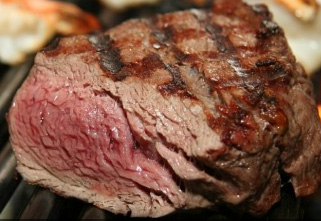
|  |  |  Entertainment | Restaurants & Dining Entertainment | Restaurants & Dining  
Steak: 5 Things You Didn't Know
 Ross Bonander - AskMen.com Ross Bonander - AskMen.com
go to original
March 15, 2010


| | Cattle producers in the U.S. have about 30 FDA-approved products at their disposal to beef up their beef, and they've been doing it for the last 60 years. |  |
Aside from the herbivores among us, who doesn't like a good steak? The folks over at People for the Ethical Treatment of Animals (PETA) probably don't. But would they, or at least some of them, if those animals were in fact treated ethically? Washington University philosopher Adam Shriver has an idea that seems to bridge the gap between answering the consumer's call for more steaks and the ethicist's cry for the humane treatment of those future steaks: He proposes genetically engineering our livestock so that they lack the ability to suffer. It's been accomplished with mice, and if livestock are to spend their lives crammed into grotesque living spaces until the hungry reaper arrives, isn't it the ethical thing to do to find a way to prevent that suffering? It would mean eating genetically engineered meat; but, hey, that meat is already juiced like an MLB clubhouse - what's one more tweak?

As that debate goes nowhere in a hurry, we present five things you didn't know about steak.

1- The average cow is about 40% steak

The first thing you didn't know about steak is just how much your standard, everyday head of cattle can produce.

A seemingly serious academic paper entitled Did the Locker Plant Steal Some of My Meat? from the department of meat sciences at South Dakota State University lays out the percentages of beef, pork and lamb with some authority: On average, assuming your beef animal weighs about 1,200 pounds and is nothing special in the muscle department, it should yield about 38% to 44% edible beef, or a good 460 pounds' worth.

2- The world’s priciest steak is nearly white when raw

You've heard of Kobe beef - how delicious, amazing and expensive is it? Kobe is a brand of Wagyu steak, a Japanese product that is so in demand worldwide that Wagyu brands typically make for the top 5 or 10 priciest steaks anywhere.

Why so pricey? These are cattle raised with kid gloves; they hardly work a day in their life, and if you believe the myth, they're even privy to the occasional massage. The result is a cut of beef so streaked with fat that, when raw, the meat is so pale it's nearly white.

3- Four of every five fail the Big Texas Steak Ranch Challenge

Another thing you didn't know about steak is that it brings out the best in us - or the worst.

The world famous Big Texas Steak Ranch Challenge in Amarillo has been tempting both gluttons and cheapskates to devour one 72-ounce steak, a shrimp cocktail, a salad, a baked potato, and a dinner roll, all in under one hour. If you fail, you pay for the meal (about $72); if you succeed, you get it for free. In the decades since the offer was first extended, over 48,000 people have tried. About 8,000 have succeeded. The current record holder ate it all in 8.52 minutes. A handful of people have achieved this more than once, and a select one or two, apparently, have eaten two challenges worth in under an hour.

If you can't make it to Amarillo, the Big Texas Ranch Challenge’s website allows you to tune in to a live webcam trained on the special table.

4- The word “steak” derives from meat on a stick

Generally, when we say “steak” we mean beef - a porterhouse, rib eye, filet mignon - but the term itself can refer to a slice of meat from just about any edible animal. Who knows, maybe even cannibals use the term.

Either way, it comes down to us from the Saxons, conquerors of the island of Britain and apparently a skilled bunch when it came to cattle rustling. Their term was steik and it referred to the basics: meat on a stick.

5- Growth hormones make an extra 700 million pounds of steak

The last thing you didn't know about steak is that when it comes to being juiced, baseball players have nothing on cows.

Called growth promotants, growth hormones or plain old steroids, cattle producers in the U.S. have about 30 FDA-approved products at their disposal to beef up their beef, and they've been doing it for the last 60 years. These products feature estrogens, androgens and progestins, and according to a University of Minnesota study, these steroids contribute an additional 700 million pounds of beef per year to the plates of hungry consumers while saving ranchers about six billion pounds of feed. |

 |
|  |



